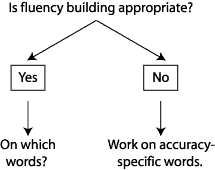Fluency

Teaching Strategies and Examples: Irregular Word Fluency
Defining Irregular Words
Distinguishing between irregular words and regular words is essential. Although the end goal of both is that students recognize words automatically, it is the process they use to achieve fluency that is important.
Examine the following words from the Reading Teacher's Book of Lists to determine which you would teach as irregular.
| the | of | and | a | to | in |
Step 1: Is Fluency Building Appropriate?
- Examine student's performance on a list of irregular words or in connected text. Is irregular word reading accurate but slow?
- Identify target goal. No specific goal is available for irregular words. In isolated word lists, use a gauge of 1 word per second as an indicator of automaticity.
- Review the following performance patterns on a list of irregular words.
- Example A: Score of 20. All correct. No errors but very slow.
- Example B: Score of 50. 65 attempts, 15 errors.
- Example C: Score of 20. 5 errors (random errors).

Step 2: How to Develop Irregular Word Reading Fluency: Mediated Scaffolding and Review
- Identify irregular words students can identify accurately but not fluently. Include these in fluency building. Words not identified accurately should be part of a different instructional set.
- Determine whether words are regular or irregular. Separate highly similar irregular words on 1st fluency building activities. Include multiple examples of each word in the set.
- Progress from accuracy to fluency by systematically decreasing the amount of time per response (3 - 2 - 1).
- Provide 2-3 short duration practice opportunities per day.
Irregular Word Fluency Building Example: The 1-Minute Dash
- Identify a set of irregular words students can correctly identify.
- Include multiple cards of each word in the set.
- Set a goal (i.e., 30 correct words per minute).
- Do a 1-minute small-group practice. Position cards so that all students can see.
- Start the stop watch.
- Present the first word card so that all students answer.
- Provide quick corrective feedback on errors.
- Continue presenting words.
- Words correctly identified go in one pile; place errors in second pile.
- At the end of 1 minute, tally the number of words correct.
- Review errors and repeat activity for 1 more minute.
Examples of Irregular Word Reading Fluency Activities
- Paired peer practice. Pair a higher performer with a child who needs fluency practice. Use similar procedures as in 1-Minute Dash. Each child may use his/her set of known but not fluent irregular words.
- Word recognition grid. Prepare a 5x5 grid of 5 irregular words. One word per row, randomly ordered. Include a short review of words. Then, do a timed recall of words.
Sample 5 x 5 Grid
